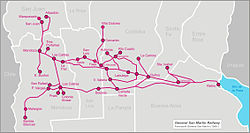General San Martín Railway
| San Martín Railway | |||
|---|---|---|---|
|
Current rolling stock at a workshop in Haedo, Buenos Aires Province.
|
|||
| Overview | |||
| Native name | Ferrocarril San Martín | ||
| Type | Inter-city | ||
| Status | Active | ||
| Locale | Buenos Aires, Santa Fe, Córdoba, San Juan, San Luis, Mendoza | ||
| Termini |
Retiro Mendoza |
||
| Operation | |||
| Opened | 1948 | ||
| Owner | Government of Argentina | ||
| Operator(s) |
Trenes Argentinos (passengers) Trenes Argentinos Cargas y Logística (freight) |
||
| Technical | |||
| Track gauge | 1,676 mm (5 ft 6 in) | ||
|
|||
The General San Martín Railway (FCGSM) (Spanish: Ferrocarril General San Martín), named after the former Argentine general José de San Martín, was one of the six state-owned Argentine railway companies formed after President Juan Perón's nationalisation of the railway network in 1948. The six companies were managed by Ferrocarriles Argentinos which was later broken up during the process of railway privatisation beginning in 1991 during Carlos Menem's presidency.
The FCGSM took over the 1,676 mm (5 ft 6 in) broad gauge British-owned company Buenos Aires and Pacific Railway.
The principal lines departed from Retiro terminus in Buenos Aires to the west through the provinces of Buenos Aires, Santa Fe, Córdoba, Mendoza, San Luis and San Juan.
The Buenos Aires and Pacific Railway had been established in London on October 10, 1882, with the purpose to build a railway from Mercedes, Buenos Aires to Villa Mercedes in San Luis Province, where the line joined to Ferrocarril Andino. The entering to the city of Buenos Aires was made through Buenos Aires Western Railway (current Ferrocarril Sarmiento) until the company built its own access to the capital city of Argentina.
...
Wikipedia

